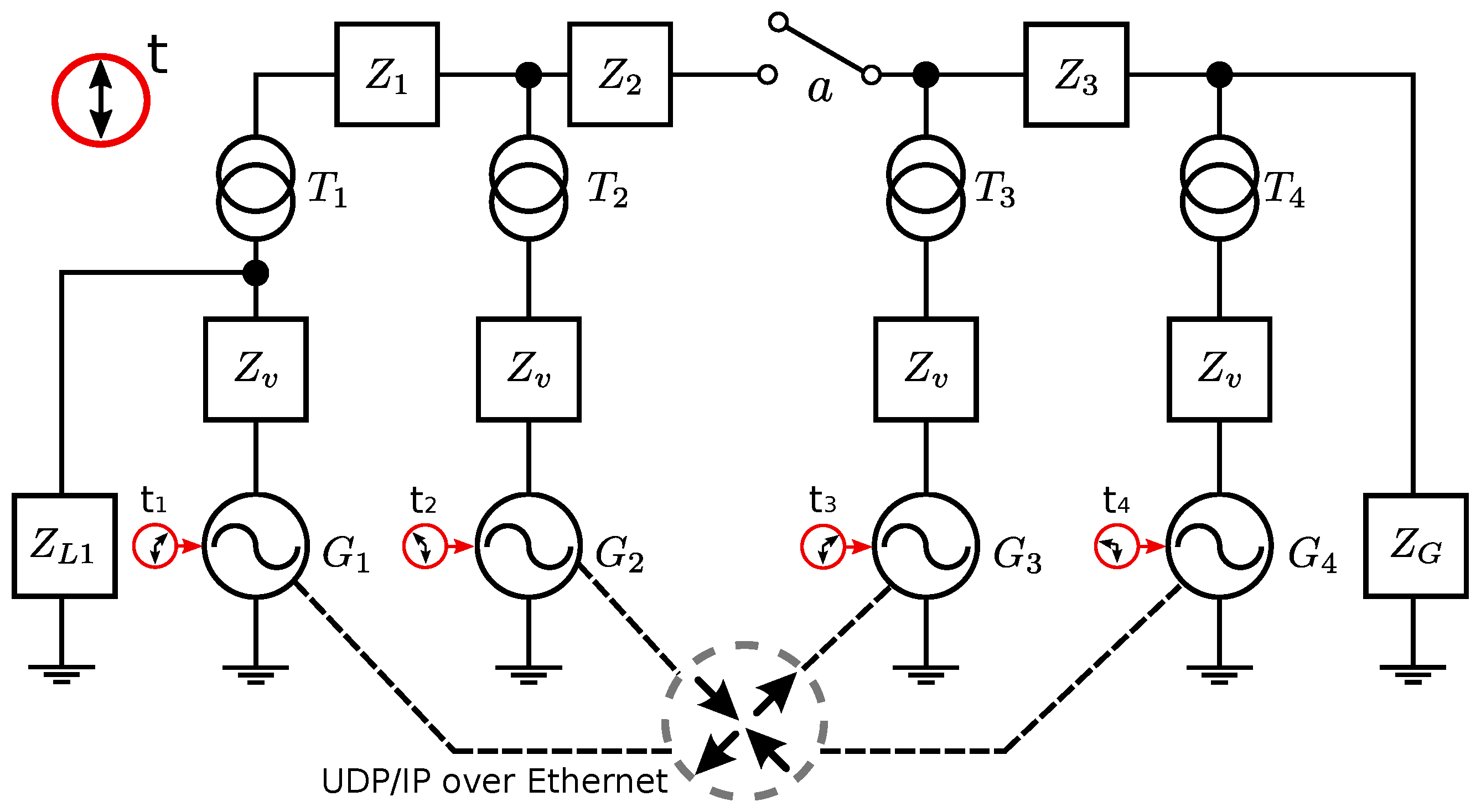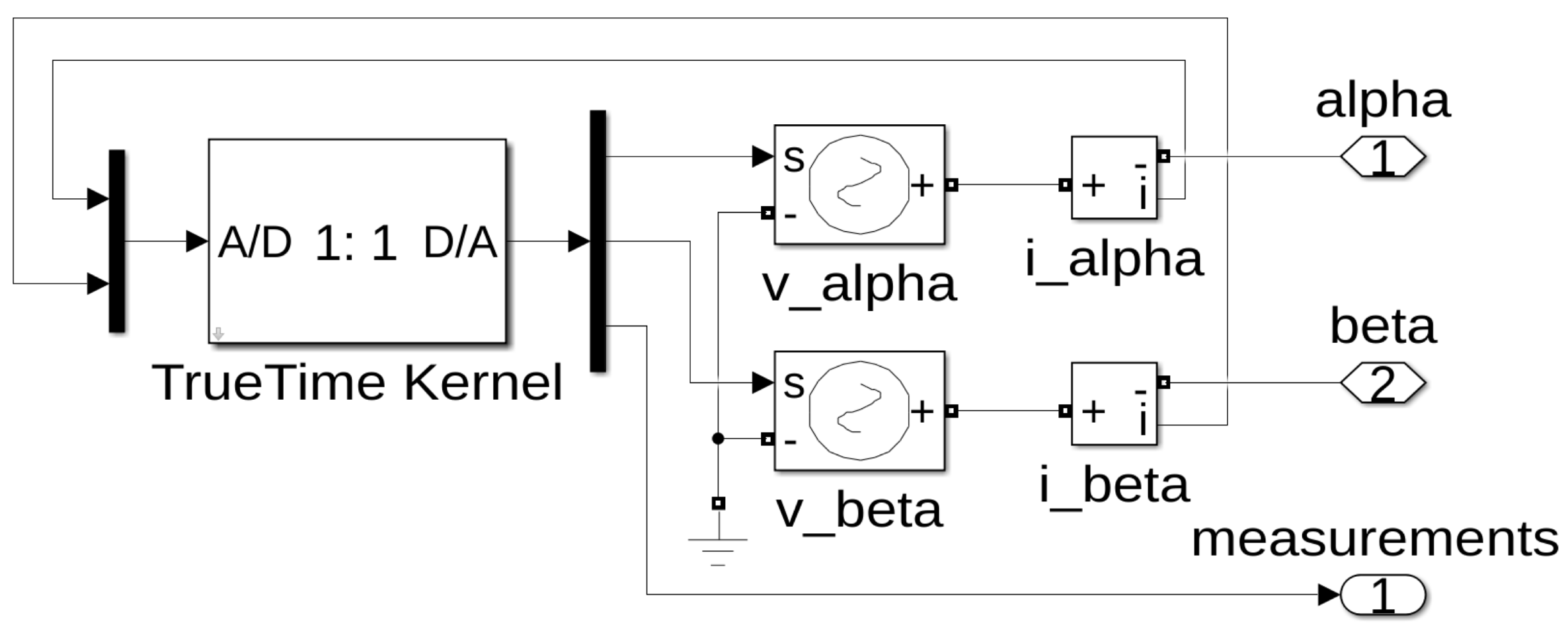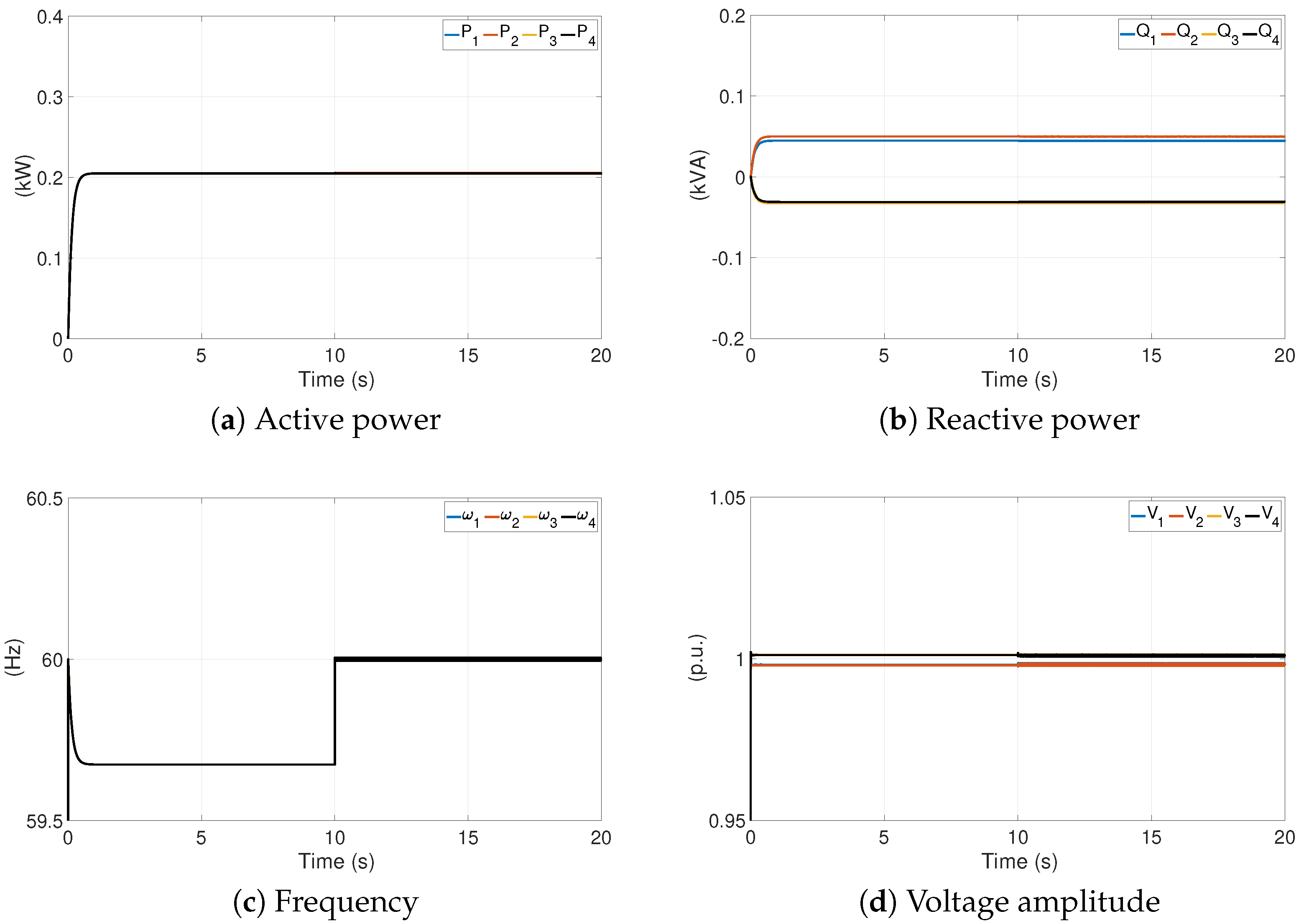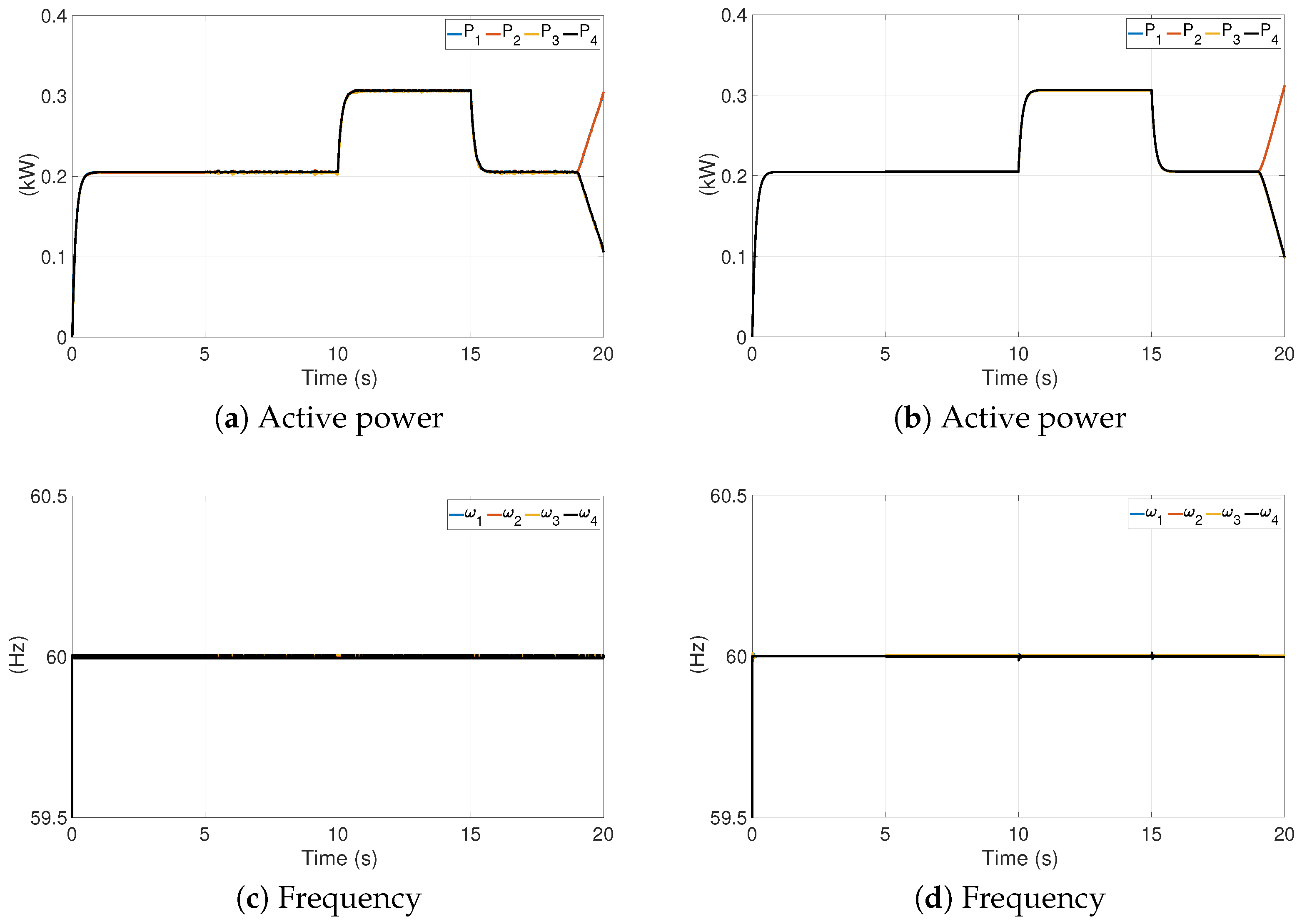Droop-Free Sliding-Mode Control for Active-Power Sharing and Frequency Regulation in Inverter-Based Islanded Microgrids
Abstract
:1. Introduction
2. Modeling the MG
2.1. Communications Network
2.2. Power Grid
3. From Droop to Droop-Free Control
Droop-Free Is Droop with Communications
4. Proposed Sliding Mode Control
4.1. Delimiting the Control Problem
- (1)
- The droop-free method has voltage control [22], but this analysis does not cover it because it departs from the frequency/active power approach presented in this work. Instead, the voltage regulation is always enabled through the conventional droop method [4] locally implemented at each node. It is expressed aswhere represents the inverter’s voltage amplitude, is the nominal voltage amplitude, is the output reactive power of the inverter, and c is the proportional control gain.
- (2)
- The active power provided by the inverters in steady state must be equal while guaranteeing the supply of the load. It can be expressed aswhere is the total power supplied by all inverters.
- (3)
- The local frequency of each inverter in steady state can be formulated asNote that the set-point frequency is the same for all VSIs.
4.2. Sliding Mode Control
4.3. Stability Analysis
5. Results
5.1. Simulation Setup
5.2. Simulation Results
6. Discussion
6.1. Active Power Sharing and Frequency Restoration
6.2. Robustness
6.3. Steady-State Error
6.4. Comparative Analysis
7. Conclusions and Future Work
Author Contributions
Funding
Conflicts of Interest
References
- Buso, S.; Caldognetto, T. Rapid prototyping of digital controllers for microgrid inverters. IEEE J. Emerg. Sel. Top. Power Electron. 2014, 3, 440–450. [Google Scholar] [CrossRef]
- Guerrero, J.M.; Vasquez, J.C.; Matas, J.; De Vicuña, L.G.; Castilla, M. Hierarchical control of droop-controlled AC and DC microgrids: A general approach toward standardization. IEEE Trans. Ind. Electron. 2011, 58, 158–172. [Google Scholar] [CrossRef]
- Olivares, D.E.; Mehrizi-Sani, A.; Etemadi, A.H.; Cañizares, C.A.; Iravani, R.; Kazerani, M.; Hajimiragha, A.H.; Gomis-Bellmunt, O.; Saeedifard, M.; Palma-Behnke, R.; et al. Trends in microgrid control. IEEE Trans. Smart Grid 2014, 5, 1905–1919. [Google Scholar] [CrossRef]
- Chandorkar, M.C.; Divan, D.M.; Adapa, R. Control of parallel connected inverters in standalone AC supply systems. IEEE Trans. Ind. Appl. 1993, 29, 136–143. [Google Scholar] [CrossRef]
- Schiffer, J.; Ortega, R.; Astolfi, A.; Raisch, J.; Sezi, T. Conditions for stability of droop-controlled inverter-based microgrids. Automatica 2014, 50, 2457–2469. [Google Scholar] [CrossRef]
- Andreasson, M.; Dimarogonas, D.V.; Sandberg, H.; Johansson, K.H. Distributed control of networked dynamical systems: Static feedback, integral action and consensus. IEEE Trans. Autom. Control 2014, 59, 1750–1764. [Google Scholar]
- Han, Y.; Li, H.; Shen, P.; Coelho, E.A.A.; Guerrero, J.M. Review of active and reactive power sharing strategies in hierarchical controlled microgrids. IEEE Trans. Power Electron. 2017, 32, 2427–2451. [Google Scholar] [CrossRef]
- Martí, P.; Torres-Martínez, J.; Rosero, C.X.; Velasco, M.; Miret, J.; Castilla, M. Analysis of the effect of clock drifts on frequency regulation and power sharing in inverter-based islanded microgrids. IEEE Trans. Power Electron. 2018, 33, 10363–10379. [Google Scholar] [CrossRef]
- Wen, S.; Yu, X.; Zeng, Z.; Wang, J. Event-triggering load frequency control for multiarea power systems with communication delays. Trans. Ind. Electron. 2016, 63, 1308–1317. [Google Scholar] [CrossRef]
- Li, C.; Yu, X.; Yu, W.; Huang, T.; Liu, Z.W. Distributed event-triggered scheme for economic dispatch in smart grids. IEEE Trans. Ind. Informat. 2016, 12, 1775–1785. [Google Scholar] [CrossRef]
- Dong, L.; Tang, Y.; He, H.; Sun, C. An event-triggered approach for load frequency control with supplementary ADP. IEEE Trans. Power Syst. 2017, 32, 581–589. [Google Scholar] [CrossRef]
- Dou, C.; Yue, D.; Guerrero, J.M. Multiagent system-based event-triggered hybrid controls for high-security hybrid energy generation systems. IEEE Trans. Ind. Informa. 2017, 13, 584–594. [Google Scholar]
- Zhou, J.; Zhang, H.; Sun, Q.; Ma, D.; Huang, B. Event-based distributed active power sharing control for interconnected AC and DC microgrids. IEEE Trans. Smart Grid 2018, 9, 6815–6828. [Google Scholar] [CrossRef]
- Mohamed, Y.A.I.; El-Saadany, E.F. Adaptive decentralized droop controller to preserve power sharing stability of paralleled inverters in distributed generation microgrids. IEEE Trans. Power Electron. 2008, 23, 2806–2816. [Google Scholar] [CrossRef]
- Hua, M.; Hu, H.; Xing, Y.; Guerrero, J.M. Multilayer control for inverters in parallel operation without intercommunications. IEEE Trans. Power Electron. 2012, 27, 3651–3663. [Google Scholar] [CrossRef]
- Rey, J.M.; Martí, P.; Velasco, M.; Miret, J.; Castilla, M. Secondary switched control with no communications for islanded microgrids. IEEE Trans. Ind. Electron. 2017, 64, 8534–8545. [Google Scholar]
- Rey, J.M.; Rosero, C.X.; Velasco, M.; Marti, P.; Miret, J.; Castilla, M. Local frequency restoration for droop-controlled parallel inverters in islanded microgrids. IEEE Trans. Energy Convers. 2019, 34, 1232–1241. [Google Scholar] [CrossRef]
- Palizban, O.; Kauhaniemi, K. Secondary control in AC microgrids: Challenges and solutions. In Proceedings of the 2015 International Conference on Smart Cities and Green ICT Systems (SMARTGREENS), Lisbon, Portugal, 20–22 May 2015. [Google Scholar]
- Simpson-Porco, J.W.; Shafiee, Q.; Dorfler, F.; Vasquez, J.C.; Guerrero, J.M.; Bullo, F. Secondary frequency and voltage control of islanded microgrids via distributed averaging. IEEE Trans. Ind. Electron. 2015, 62, 7025–7038. [Google Scholar]
- Huang, P.H.; Liu, P.C.; Xiao, W.; El Moursi, M.S. A novel droop-based average voltage sharing control strategy for DC microgrids. IEEE Trans. Smart Grid 2015, 6, 1096–1106. [Google Scholar] [CrossRef]
- Guo, F.; Wen, C.; Mao, J.; Song, Y.D. Distributed secondary voltage and frequency restoration control of droop-controlled inverter-based microgrids. IEEE Trans. Ind. Electron. 2015, 62, 4355–4364. [Google Scholar] [CrossRef]
- Nasirian, V.; Shafiee, Q.; Guerrero, J.M.; Lewis, F.L.; Davoudi, A. Droop-free distributed control for AC microgrids. IEEE Trans. Power Electron. 2016, 31, 1600–1617. [Google Scholar] [CrossRef]
- Dörfler, F.; Simpson-Porco, J.W.; Bullo, F. Breaking the hierarchy: Distributed control and economic optimality in microgrids. IEEE Trans. Control Netw. Syst. 2016, 3, 241–253. [Google Scholar] [CrossRef]
- Rosero, C.X.; Velasco, M.; Martí, P.; Camacho, A.; Miret, J.; Castilla, M. Active power sharing and frequency regulation in droop-free control for islanded microgrids under electrical and communication failures. IEEE Trans. Ind. Electron. 2020, 67, 6461–6472. [Google Scholar] [CrossRef]
- Schiffer, J.; Hans, C.A.; Kral, T.; Ortega, R.; Raisch, J. Modeling, analysis, and experimental validation of clock drift effects in low-inertia power systems. IEEE Trans. Ind. Electron. 2017, 64, 5942–5951. [Google Scholar] [CrossRef]
- Cucuzzella, M.; Incremona, G.P.; Ferrara, A. Design of robust higher order sliding mode control for microgrids. IEEE J. Emerg. Sel. Top. Circuits Syst. 2015, 5, 393–401. [Google Scholar] [CrossRef]
- Rubagotti, M.; Estrada, A.; Castanos, F.; Ferrara, A.; Fridman, L. Integral sliding mode control for nonlinear systems with matched and unmatched perturbations. IEEE Trans. Automat. 2011, 56, 2699–2704. [Google Scholar] [CrossRef]
- Utkin, V. Variable structure Systems with sliding modes. IEEE Trans. Automat. 1977, 22, 212–222. [Google Scholar] [CrossRef]
- Abdollahi, M.H.; Bathaee, S.M. Sliding mode controller for stability enhancement of microgrids. In Proceedings of the IEEE/PES Transmission and Distribution Conference and Exposition, Chicago, IL, USA, 21–24 April 2008; pp. 1–6. [Google Scholar]
- Pilloni, A.; Pisano, A.; Usai, E. Robust finite-time frequency and voltage restoration of inverter-based microgrids via sliding-mode cooperative control. IEEE Trans. Power Electron. 2018, 65, 907–917. [Google Scholar]
- Sarrafan, N.; Rostami, M.A.; Zarei, J.; Razavi-Far, R.; Saif, M.; Dragicevic, T. Improved distributed prescribed finite-time secondary control of inverter-based microgrids: Design and real-time implementation. IEEE Trans. Ind. Electron. 2020, 68, 11135–11145. [Google Scholar]
- Alfaro, C.; Guzman, R.; De Vicuña, L.G.; Komurcugil, H.; Martín, H. Distributed direct power sliding-mode control for islanded AC microgrids. IEEE Trans. Ind. Electron. 2022, 69, 9700–9710. [Google Scholar] [CrossRef]
- Incremona, G.P.; Cucuzzella, M.; Ferrara, A. Adaptive suboptimal second-order sliding mode control for microgrids. Int. J. Control 2016, 89, 1849–1867. [Google Scholar]
- Morstyn, T.; Savkin, A.V.; Hredzak, B.; Agelidis, V.G. Multi-agent sliding mode control for state of charge balancing between battery energy storage systems distributed in a DC microgrid. IEEE Trans. Smart Grid 2017, 9, 4735–4743. [Google Scholar]
- Veysi, M.; Aghaei, J.; Soltanpour, M.R.; Shasadeghi, M.; Bahrani, B.; Ryan, D.J. Robust, accurate, and fast decentralized power sharing mechanism for isolated DC microgrid using droop-based sliding-mode control. IEEE Trans. Smart Grid 2022, 13, 4160–4173. [Google Scholar]
- Kundur, P.S.; Malik, O.P. Power System Stability and Control; McGraw-Hill Education: New York, NY, USA, 2022. [Google Scholar]
- Tao, G. Model reference adaptive control with L1+α tracking. Int. J. Control 1996, 64, 859–870. [Google Scholar]
- Hosseinzadeh, M.; Yazdanpanah, M.J. Performance enhanced model reference adaptive control through switching non-quadratic Lyapunov functions. Syst. Control Lett. 2015, 76, 47–55. [Google Scholar]
- Rosero, C.X.; Vaca, C.; Gavilanez, M.; Iglesias, I.; Rosero, R. Towards a simulation platform for islanded microgrids based on grid-forming power converters. In Proceedings of the IEEE 5th Colombian Conference on Automatic Control (CCAC), Virtualy, Ibague, Colombia, 19–22 October 2021; pp. 1–6. [Google Scholar]
- Mohammed, N.; Lashab, A.; Ciobotaru, M.; Guerrero, J.M. Accurate Reactive Power Sharing Strategy for Droop-Based Islanded AC Microgrids. IEEE Trans. Ind. Electron. 2023, 70, 2696–2707. [Google Scholar]






| Symbol | Description | Value |
|---|---|---|
| Grid voltage (rms line to line) | V | |
| Grid frequency (at no load) | rad/s | |
| Transmission line impedance | 1.3 m | |
| Transmission line impedances 2 and 3 | 1 m | |
| Transformer impedances 1 and 2 | 0.62 m | |
| Transformer impedances 3 and 4 | 1.31 m | |
| max | Maximum global load impedance | 88 |
| min | Minimum global load impedance | 44 |
| Local load impedance 1 | 88 | |
| Virtual impedance | 3.76 m | |
| Gains for voltage droop | 1 V/(VAr) | |
| Gains for frequency droop | 1 mrad/(Ws) | |
| Gains for frequency compensation in sliding mode | mrad/(Ws) | |
| Gains for droop-free | 10 mrad/(Ws) | |
| Clock drift rate in | ppm | |
| Clock drift rate in | ppm | |
| Clock drift rate in | ppm | |
| Clock drift rate in | ppm | |
| Sampling period | ms | |
| Data transmission period | ms |
| Control Method | Advantages | Disadvantages |
|---|---|---|
| Droop-free SM | Minimal active power steady-state error | Frequency chattering |
| Robust to clock drifts and load changes | Unstable in communication partitions | |
| Easy to implement | ||
| Opportunity to be improved through filtering techniques for chattering and additional sliding surface for reactive power sharing | ||
| Droop-free | Robust to clock drifts and load changes | Unstable in communication partitions |
| Minimal steady-state errors for active power and frequency |
Disclaimer/Publisher’s Note: The statements, opinions and data contained in all publications are solely those of the individual author(s) and contributor(s) and not of MDPI and/or the editor(s). MDPI and/or the editor(s) disclaim responsibility for any injury to people or property resulting from any ideas, methods, instructions or products referred to in the content. |
© 2023 by the authors. Licensee MDPI, Basel, Switzerland. This article is an open access article distributed under the terms and conditions of the Creative Commons Attribution (CC BY) license (https://creativecommons.org/licenses/by/4.0/).
Share and Cite
Rosero, C.X.; Gavilánez, M.; Mejía-Echeverría, C. Droop-Free Sliding-Mode Control for Active-Power Sharing and Frequency Regulation in Inverter-Based Islanded Microgrids. Energies 2023, 16, 6442. https://doi.org/10.3390/en16186442
Rosero CX, Gavilánez M, Mejía-Echeverría C. Droop-Free Sliding-Mode Control for Active-Power Sharing and Frequency Regulation in Inverter-Based Islanded Microgrids. Energies. 2023; 16(18):6442. https://doi.org/10.3390/en16186442
Chicago/Turabian StyleRosero, Carlos Xavier, Milton Gavilánez, and Cosme Mejía-Echeverría. 2023. "Droop-Free Sliding-Mode Control for Active-Power Sharing and Frequency Regulation in Inverter-Based Islanded Microgrids" Energies 16, no. 18: 6442. https://doi.org/10.3390/en16186442
APA StyleRosero, C. X., Gavilánez, M., & Mejía-Echeverría, C. (2023). Droop-Free Sliding-Mode Control for Active-Power Sharing and Frequency Regulation in Inverter-Based Islanded Microgrids. Energies, 16(18), 6442. https://doi.org/10.3390/en16186442






